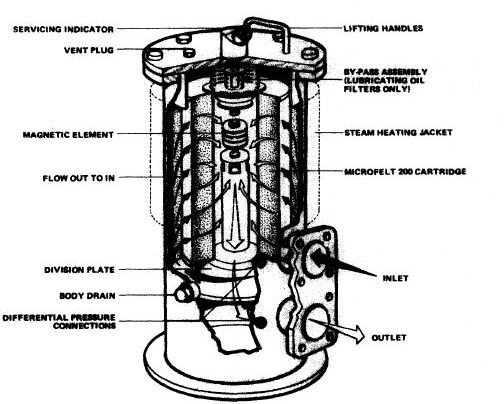Fuel oil filter study - Construction and working of these filters on ships
Introduction
Filters are used everywhere on all types of ships, right from sea water system to fuel oil systems. We will study about fuel oil filters here.
As discussed in the previous article, a strainer is a kind of coarse filter which is used for filtering large impurities and contaminants present in the fuel oil. A filter is used for fine filtration of smaller particles which are allowed to pass through by a strainer. Just as in the case of strainers, filters are always mounted in pairs, with one working and other as a standby.
Fine filters are full flow units and are used for purifying oil entering delicate and complex parts of the main engine and auxiliaries. Even the smallest of the dirt particle is removed with the help of fine filter.This finely filtered oil can be used in the sensitive finely machined engine parts of the fuel injection system or the bearings of the rotating machinery.
Construction and Working
The assembly of the filter is almost same as that of a strainer but the filtering material is different. In a strainer a wire mesh is used while in a filter natural or synthetic fibrous felt or paper is used. This fibrous felt type fine filter comes in a cylindrical arrangement known as cartridge. In the main filter assembly, a steel division plate divides the steel pressure vessel into an upper and a lower chamber. This is done to facilitate a unidirectional flow of the oil.
The dirty oil that is to be filtered enters the upper chamber of the assembly, gets filtered and then through the central hollow passage flows to the lower chamber. The oil flows through the lower chamber and out of the unit to get further purified.
Magnetic Filters
Apart from the conventional filters, there are also magnetic filters, which are used to remove fine iron particles from the system. The arrangement of a magnetic filter is same as that of a fine filter, but with a magnetic element placed in the central tube. In such systems, a spring loaded by-pass valve is provided to ensure the flow of the lubricating oil in case the filter gets chocked. Moreover, a back flushing system is also provided for cleaning the filter element while the filter is still inside the assembly. Back flushing is generally done using compressed air but the back flushing process can be done only for a specific number of times. If the filter doesn’t show any improvement even after consecutive back flushing, then the filter should be replaced. Both the filters work alternatively for the filtration process.
Types of Filteration Systems
Generally there are two types of filtration system :
- Full flow system
- By-pass system
In a full flow system , all the oil passes through the filter while flowing to the engine, whereas in a by pass system, only a part of oil goes to the filter while the rest goes to the lubrication system. A by pass system is used to attain higher pressure drop across the filter and also to make the filtration process slower and efficient. A centrifugal filter can also be used in a by-pass system. The centrifugal filter consists of a rotor, which rotates at a high speed and through which the oil passes. The oil is thrown away from the rotor due to the centrifugal force and the impurities stay at the rotor. The clean oil returns to the sump and the impurities at the rotor are removed through a special arrangement. This type of filter never gets chocked and requires no replacement element.

Images
Harrington, R.L. (1992) Marine Engineering. New Jersey: Society of Naval Architects and Marine Engineers
